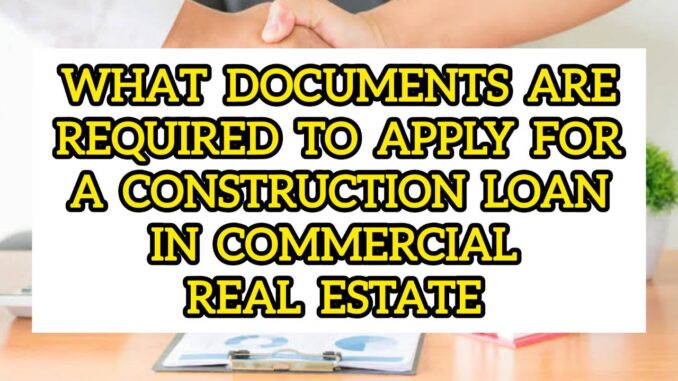
Have you ever wondered what paperwork you need to secure a construction loan for your commercial real estate project? It’s not just about having a great idea or a prime location. Lenders want to see a mountain of documents before they commit millions of dollars to your vision. In this article, we’ll dive deep into every form, report, and certification you’ll need to gather, organize, and present to win your lender’s confidence—and their financing.
Overview of Commercial Construction Loans
When you’re building an office tower, retail center, or mixed-use complex, traditional mortgages won’t cut it. Commercial construction loans are structured differently, with draw schedules, progress inspections, and strict covenants. The lender’s job is to manage risk every step of the way, which means they need comprehensive due diligence. Understanding their perspective is the first step toward smooth approval.
Understanding Lender Requirements
Each lender has its own checklist, but most follow a similar blueprint. They want proof of identity, financial strength, project feasibility, collateral value, and risk mitigation. Think of yourself as pitching a blockbuster movie: you need a strong cast (your team), a solid script (your plans), a realistic budget, and insurance in case production goes sideways. Without those documents, your project won’t make it past the first round.
Proof of Identity and Entity Documents
Lenders need to confirm who you are—both as an individual and as a business entity. They’ll ask for legal documentation that proves you exist, operate legitimately, and have authority to sign.
Personal Identification Requirements
You’ll typically need a government-issued ID such as a passport or driver’s license. If you’re an international investor, you may also need a visa or work permit. These documents verify that you’re who you claim to be and that you have the legal capacity to sign loan documents.
Business Entity Formation Documents
For companies, lenders require formation paperwork: articles of incorporation for corporations, operating agreements for LLCs, and partnership agreements for partnerships. They want to confirm your business structure, ownership percentages, and who has signing authority. If you’re a special purpose vehicle (SPV) set up just for this project, include those formation documents too.
Financial Statements and Tax Documentation
Nothing speaks louder to lenders than cold, hard numbers. They want to see your financial health at both the personal and business levels.
Personal Tax Returns
Expect to provide at least two to three years of personal tax returns. These returns demonstrate your income, deductions, and net worth. They also help lenders assess your capacity to contribute equity and guarantee the loan if required.
Business Tax Returns
If your entity has existed for multiple years, submit two to three years of business tax returns. These statements show revenue streams, expenses, and profitability. Consistent profitability reassures lenders that you can handle the financial ups and downs of construction.
Audited Financial Statements
For larger projects or publicly traded entities, lenders often require audited financial statements prepared by a certified public accountant. Audits add credibility, because an independent third party has verified your books. Think of it as the gold standard for financial transparency.
Detailed Project Plan
Lenders need to visualize what you’ll build—and how you’ll build it. A detailed project plan tells the story.
Architectural and Engineering Plans
Your architectural renderings and engineering blueprints are the backbone of your loan package. They detail scope of work, dimensions, materials, and technical specifications. Without clear drawings, lenders can’t assess the realism of cost estimates or the timeline.
Project Schedule and Timeline
A Gantt chart or similar schedule lays out each phase: site work, foundation, superstructure, MEP (mechanical, electrical, plumbing), finishes, and punch list. Lenders use this timeline to structure draw schedules and monitor progress. If your schedule is overly optimistic or vague, they’ll question your planning skills.
Materials and Cost Estimates
Break down your budget into hard costs (concrete, steel, labor) and soft costs (architect fees, permits, insurance). Acquire detailed bids from subcontractors and suppliers. Lenders cross-check these estimates against industry benchmarks to ensure you’re not underestimating costs. Inflated budgets or generic line items raise red flags.
Appraisal and Market Analysis
Your lender needs to know the project’s ultimate value and its place in the marketplace.
Property Appraisal Reports
An independent appraiser evaluates your site and projected improvements. They consider comparable properties, land values, replacement costs, and market demand. The appraisal justifies your loan-to-cost (LTC) and loan-to-value (LTV) ratios.
Market Feasibility Studies
Market studies assess supply and demand, rental rates, absorption rates, and demographic trends. They answer questions like: Will businesses rent that office space? Can you sell those retail condominiums? Feasibility analyses give lenders confidence that you won’t be left holding empty shells.
Environmental and Regulatory Documents
Building anything larger than a shed means navigating environmental and zoning rules.
Environmental Site Assessments
Phase I and Phase II Environmental Site Assessments (ESAs) identify contamination risks such as hydrocarbons, asbestos, or underground storage tanks. Lenders won’t fund a project that might trigger multi-million-dollar cleanup costs down the road.
Zoning and Land Use Approvals
Provide zoning confirmation letters, land use permits, and any required zoning variances. These documents show that your project complies with local regulations. If you need special approvals—like a conditional use permit—include evidence of application or approval to avoid unexpected delays.
Collateral and Equity Contribution Proof
Construction loans typically require a mix of debt and equity. Lenders want proof of both.
Source of Funds Documentation
Whether you’re using personal savings, partner equity, or institutional capital, prove your ability to deliver. Bank statements, investment account statements, and capital call agreements show where your equity is coming from and that funds are “clean” (i.e., legally obtained).
Equity Investment Agreements
If you have investors or limited partners, include signed subscription agreements or investment commitment letters. These documents confirm equity sources and timelines, ensuring lenders you can meet draw requirements.
Contractor and Construction Team Credentials
Your general contractor (GC) and key subcontractors drive the build. Lenders vet their capabilities thoroughly.
General Contractor Licensing
Provide copies of the GC’s state licenses, business registrations, and proof of good standing. A licensed contractor reduces risk, because licensing boards enforce certain standards and oversight.
Insurance and Bonding Certificates
Contractors must carry insurance: general liability, workers’ compensation, and builder’s risk. They may also need performance bonds or payment bonds under a Miller Act or similar local requirement. These certificates protect both you and the lender if something goes wrong on site.
Loan Application Forms and Disclosures
Nothing magical happens without filling out the lender’s own forms.
Standard Loan Application
This document collects project details, financing needs, borrower information, and guarantor data. Answer every question fully and honestly. Incomplete forms slow processing and raise suspicion.
Truth-in-Lending Disclosures
Under the Truth-in-Lending Act (TILA), lenders must disclose interest rates, fees, APR, and other loan terms. Review these carefully, as errors can trigger legal headaches or delayed closings.
Title and Legal Documents
Clear title is non-negotiable. Lenders need assurance that your collateral is free from liens and encumbrances.
Title Insurance Commitment
Obtain a title insurance commitment showing your ownership chain and any exceptions or reservations. Title insurance protects the lender (and you) against hidden title defects.
Survey and Legal Description
Provide a recent land survey and legal description of the property. Surveys reveal encroachments, easements, and boundary issues. Legal descriptions tie the collateral precisely to the loan documents.
Insurance and Risk Management
Building sites face unique risks. Insurance mitigates those risks.
Builder’s Risk Insurance
Builder’s risk covers physical damage to construction materials, equipment, and the structure itself during construction. Policies often extend to theft, vandalism, fire, and weather events.
Liability Insurance Policies
General liability and umbrella policies protect against third-party claims from injuries or property damage on the job site. Lenders require minimum coverage limits to guard against lawsuits that could sideline your cash flow.
Guarantees and Personal Covenants
Many commercial loans require personal or corporate guarantees.
Personal Guarantees
Borrowers with limited operating history often sign personal guarantees, making them personally liable for loan repayment if the project defaults. Lenders use guarantees to hold developers accountable.
Intercreditor Agreements
If mezzanine debt or subordinate lenders are involved, an intercreditor agreement establishes the pecking order of claims. Lenders won’t fund a project without clarity on who gets paid first in a workout.
Additional Lender-Specific Requirements
Beyond the standard list, each lender may have unique needs.
Third-Party Reports
Some lenders require geotechnical reports, drainage studies, or traffic impact analyses, depending on project specifics. These reports drill deeper into site-specific risks.
Lender’s Checklist
Always request the lender’s checklist early. It enumerates every document they require and helps you track your progress. Missing one item can stall your approval for weeks.
Organizing and Presenting Your Documents
Submitting a tidy, organized loan package can shave weeks off your approval timeline. Group documents by category, tab them, and include a table of contents. Consider PDF bookmarks for digital submissions. Presentation matters—if lenders can’t find what they need, they’ll ask questions, and time is money.
Common Pitfalls and How to Avoid Them
Even veteran developers trip up. Forgetting to notarize documents, missing environmental reports, or submitting stale financials can derail your approval. Double-check deadlines, confirm document expiration dates (like insurance certificates), and maintain version control on evolving documents like budgets.
Tips for a Smooth Loan Approval Process
Start early. Engage consultants—appraisers, environmental engineers, surveyors—as soon as you break ground on financing. Communicate proactively with your lender, flagging potential issues before they become deal killers. Build buffer time into your schedule. And above all, maintain transparency: lenders appreciate candor and will work with you when you’re upfront.
Conclusion
Applying for a commercial construction loan is a marathon, not a sprint. You’ll need a robust package of identity documents, financial statements, project plans, appraisals, environmental reports, insurance certificates, guarantees, and more. While the list may seem daunting, methodical organization and proactive communication with your lender can turn the paperwork mountain into a manageable molehill. With the right documents in hand, you’ll secure financing with confidence and focus on what matters most: bringing your commercial vision to life.
FAQs
How far in advance should I start gathering documents?
Begin assembling your loan package at least three months before your desired loan closing. Early engagement with consultants and lenders ensures you have time to address any gaps or unexpected requirements.
Do I need updated financials if my project closing is delayed?
Yes. Lenders typically require financial statements and tax returns within 60 to 90 days of closing. If your closing slips beyond that window, expect to supply updated documents to reflect current conditions.
Can I use verbal agreements with contractors instead of written bids?
No. Lenders insist on written, signed contracts and detailed bids to validate cost estimates. Verbal agreements lack enforceability and transparency, increasing lender risk.
What happens if I miss a document requirement?
Missing documents can stall your approval or trigger additional due diligence. In worst-case scenarios, lenders may pull commitments. Always cross-check your package against the lender’s checklist before submission.
Are digital document submissions acceptable?
Most lenders now accept—or even prefer—digital submissions. Use secure file-sharing platforms, ensure PDFs are bookmarked and searchable, and maintain clear file naming conventions. Digital organization can accelerate review and reduce errors.

West is both an engineer and a construction manager with a solid ten-year track record in directing building projects and managing their financial aspects. Throughout his career, he has honed his skills in coordinating multidisciplinary teams, streamlining budget processes, and structuring financing plans that ensure projects are delivered on time and within financial targets.
Leave a Reply